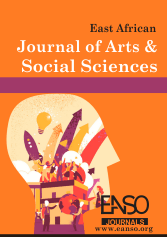Adult Attachment Styles of Adults Who Were Raised in Children’s Homes in Kenya
Abstract
The type of care given during childhood has an impact on beliefs, attitudes, and expectations of future relationships. Being raised in a children’s home or other institutionalised care has been seen to increase the risk for emotional, cognitive, developmental and attachment disorders. Attachment styles are ways in which individuals emotionally connect or relate to others. The attachment style can either be secure, which is considered healthy or insecure which is considered unhealthy. The objective of this study was to find out the adult attachment styles among adults who were raised in children’s homes in Kenya. The study adopted the descriptive survey design, and 294 respondents were sampled via census approach. The questionnaire was used for data collection. The standardised revised Adult Attachment Scale was used to measure adult attachment styles. The results of the study showed that the anxious attachment style was the highest adult attachment style among the care leavers (M = 16.09, SD = 6.24), the secure attachment style (M = 15.90, SD = 4.91) and lastly, avoidant attachment (M = 12.63, SD = 4.14). On each of the attachment style domains, 42.9% had moderate secure attachment 78. % low avoidant attachment and 15.6% had a high anxious attachment style. Based on the findings, it is recommended that organisations supporting care leavers should facilitate periodic workshops on the impact of adult attachment style on care leavers in order to create awareness and provide support
Downloads
References
Ainsworth, M. D. S. (1989). Attachments beyond infancy. American Psychologist, 44, 709-716.
Atwine, B., Cantor-Graae, E., & Bajunirwe, F (2005). Psychological Distress among AIDS orphans in rural Uganda. Social Science and Medicine, 61, 555-564.
Australian Institute of Health and Welfare. (2012). Child Protection Australia 2010–11, Child Welfare series no. 53. Cat. no. CWS 41. Canberra: Author.
Bakermans-Kranenburg, M., Dobrova-Krol, N., & van IJzendoorn, M. (2012). Impact of institutional care on attachment disorganisation and insecurity of Ukrainian preschoolers: Protective effect of the long variant of the serotonin transporter gene (5HTT). International Journal of Behavioral Development, 36(1), 11–18. doi:10.1177/0165025411406858
Bernier, A., Ackerman, J., & Stovall-McClough, C. (2004). Predicting the quality of attachment relationships in foster care dyads from infants’ initial behaviors upon placement. Infant Behavior & Development, 27, 366–381. doi:10.1016/j
Bowlby J: Attachment and loss: Vol. I. Attachment. Basic Books, New York, 1969.
Campbell, L., & Stanton, S. C. (2019). Adult attachment and trust in romantic relationships. Current opinion in psychology, 25, 148-151
Carr, A., Duff, H., & Craddock, F. (2018). A systematic review of reviews of the outcome of severe neglect in under-resourced childcare institutions. Trauma, Violence, & Abuse 21(3), 484–497. https://doi.org/10.1177/1524838018777788.
Chaitkin, S., Cantwell, N., Gale, C., Milligan, I., Flagothier, C., O’Kane, C., & Connelly, G. (2017). Towards the right care for children: Orientations for reforming alternative care systems in Africa, Asia, and Latin America. Retrieved from: http://dx.doi.org/10.2841/069502.
Cluver, L. & Gardner, F. (2006, July 19). The psychological well-being of children orphaned by AIDS in Cape Town, South Africa. Ann Gen Psychiatry, 5(8).
Collins, N. L., & Read, S. J. (1996). Adult attachment, working models, and relationship quality in dating couples. Journal of Personality and Social Psychology, 58(4), 644–663
Conde, A., Figueiredo, B., & Bifulco, A. (2011) Attachment style and psychological adjustment in couples. Attachment & Human Development, 13(3), 271-291, DOI: 10.1080/14616734.2011.562417
Cotton, D. R., Nash, P., & Kneale, P. E. (2014). The experience of care leavers in UK higher education. Widening Participation and Lifelong Learning, 16(3), 5-21.
Ddumba-Nyanzi, I., Fricke, M., Max, A. H., Nambooze, M., & Riley, M. (2019). The care leaver experience: A report on children and young people’s experiences in and after leaving residential care in Uganda
Doinita, N. E., & Maria, N. D. (2015). Attachment and parenting styles. Procedia-Social and Behavioral Sciences, 203, 199-204.
Eriksson, L., Arnautovska, U., McPhedran, S., Mazerolle, P., & Wortley, R. (2021). Child and Adult Attachment Styles among Individuals Who Have Committed Filicide: The Case for Examining attachment by gender. 20(1), 63-79
Foley, N. (2022, October 20). Support for care leavers. commonslibrary.parliament.uk. Retrieved from: https://researchbriefings.files.parliament.uk
Han, C., Ssewamala, F. M., & Wang, J. S. (2013). Family economic empowerment and mental health among AIDS-affected children living in AIDS-impacted communities: Evidence from a randomised evaluation in southwestern Uganda. Journal of Epidemiology and Community Health, 67(3), 225–230
Hecker T, Mkinga G, Kirika A, Nkuba M, Preston J, & Hermenau K. (2021). Preventing maltreatment in institutional care: A cluster-randomised controlled trial in East Africa. Prev Med Rep. 24, 101593. doi: 10.1016/j.pmedr.2021.101593. PMID: 34976652; PMCID: PMC8683896.
Hermenau, K., Kaltenbach, E., Mkinga, G., Hecker, T. (2015). Improving care quality and preventing maltreatment in institutional care – a feasibility study with caregivers. Front. Psychol. 6, 937. https://doi.org/10.3389/fpsyg.2015.00937
Hyde, R. (2018). Care leavers’ perspectives on facilitators and barriers to effective preparation for adulthood (Doctoral dissertation, University of Manchester).
Karimli L, & Ssewamala FM (2015). Do savings mediate changes in adolescents’ future orientation and health-related outcomes? Findings from randomised experiment in Uganda. Journal of Adolescent Health, 57(4), 425–432
Kelly, R. (2017). Only 6% of care leavers go to university: They deserve better chances. The guardian. https://www.theguardian.com
Kong, S.S., Kang, R. D., Jung, O. M., & Kim, H. N. (2018) Attachment insecurity as a mediator of the relationship between childhood trauma and adult dissociation, Journal of Trauma & Dissociation, 19(2), 214-231, DOI: 10.1080/15299732.2017.1329772
Lerch, V. & Stein, M. (2010). Ageing Out of Care, from care to adulthood in European and Central Asian Societies, Austria. SOS Children’s Villages, 129-134.
Li, X., Naar-King, S., Barnett, D., Stanton, B., Fang, X., Thurston, C., Turston, C., (2008). A developmental psychopathology framework of the psychosocial needs of children orphaned by HIV. J. Assoc. Nurses AIDS Care 19 (2), 147–157. https://doi.org/ 10.1016/j.jana.2007.08.004.
Luevano, X. V., Pablo, N. J., Velazquez, L.M., Chance, B., & Ramirez, B. (2021). Attachment as a predictor of attraction to humor styles. Personality and Individual Differences, 173. https://doi.org/10.1016/j.paid.2021.110634.
Magai, C., Cohen, C., Milburn, N., Thorpe, B., McPherson, R., & Peralta, D. (2001). Attachment styles in older European American and African American adults. The Journals of Gerontology Series B: Psychological Sciences and Social Sciences, 56(1), S28-S35.
Makuu M.J. (2019). Situation analysis of orphans and vulnerable children in existing alternative care systems in Dar es Salaam, Tanzania. Social Work & Society, 17(1).
Merz, E. & Consedine, S. N. (2009). The association of family support and well-being in later life depends on adult attachment style. Attachment & Human Development, 11(2), 203-221, DOI: 10.1080/14616730802625185
Milligan, I., Withington, R., Connelly, G., & Gale, C. (2016). Alternative child care and deinstitutionalisation in sub-Saharan Africa. Celcis. Retrieved from: https//:www.celcis.org
Moon, Y. C., & Jin, S. K. (2013). Relationship between Adult Attachment and Psychological Well-Being of University Students: The Mediating Effects of Empathic Ability and Depression. Korean journal of human ecology, 22(6), 599-613.
Muadi, M., Aujoulat, I., Wintgens, A., Matonda ma Nzuzi, T., & Pierrehumbert, B. (2012). Attachment of abandoned children rises in residential institutions in Kinshasa. Neuropsychiatrie de l’enfance et de l’adolescence, 60, 505–515.
Owuor, A. H. & Karega, M. (2020). Relationship between Attachment Styles and Risk For Problematic Drug Use Among Undergraduate Students in Selected Universities In Kenya. African journal of alcohol and drug abuse, 2, 20-30.
Paulson, D. & Bassett, R. (2016) Prepared to care: adult attachment and filial obligation. Aging & Mental Health, 20(11), 1221-1228, DOI: 10.1080/13607863.2015.1072800
Polkovnikova-Wamoto, A., Mathai, M., Stoep, A. V., & Kumar, M. (2016). ‘Haven of safety’ and ‘secure base’: a qualitative inquiry into factors affecting child attachment security in Nairobi, Kenya. Vulnerable children and youth studies, 11(4), 286–296. https://doi.org/10.1080/17450128.2016.1201237
Procaccia, R., Neimeyer, A. R., & Castiglioni, M. (2018). Chilren’s representations of death: The role of age and attachment style. Tpm, 25(4) 549-569. doi:10.4473/TPM25.4.6
Procaccia, R., Veronese, G., & Castiglioni, M. (2014). The impact of attachment style on the family drawing of school-aged children. The open psychology journal, 7, 9-17.
Schaffer, H. R., & Emerson, P. E. (1964). The development of social attachments in infancy. Monographs of the society for research in child development, 1-77.
Sherr, L., Roberts, K.J., & Gandhi, N. (2017). Child violence experiences in institutionalised/ orphanage care. Psychological Health Med. 22 (sup1), 31–57. https://doi.org/10.1080/ 13548506.2016.1271951
Simon, P. E. & Baxter, A. L. (2009). Attachment‐style differences in relationship maintenance strategies. Western journal of communication, 57(4), 416-430
Shi, L. (2003) The Association Between Adult Attachment Styles and Conflict Resolution in Romantic Relationships. American Journal of Family Therapy, 31(3), 143-157, DOI: 10.1080/01926180301120
Smith, G. P. (2017). Historical Out-of-home Child Care Leavers and Mental Health Needs. Australian Social Work, 70(1), 1-3.
Ssewamala, F. M., Karimli, L., Torsten, N., Wang, J. S., Han, C., Ilic, V., & Nabunya, P. (2015). Applying a family-level economic strengthening intervention to improve education and health-related outcomes of school-going AIDS-orphaned children: Lessons from a randomised experiment in Southern Uganda. Prevention Science, 17(1), 134–143
Ugandan Care Leavers (2019). The care leaver experience. A report on children and young people’s experiences in and after leaving residential care in Uganda. Uganda: Uganda Care Leavers
UNICEF. (2017, July). Key global charts and figures. Retrieved from https://data.unicef.org/topic/hivaids/adolescents-young-people
United Kingdom Department of Education. (2018). Residential care in England. Retrieved from: https://assets.publishing.service.gov.uk
van IJzendoorn, M.H., Palacios, J., Sonuga-Barke, E. J., Gunnar, M. R., Vorria, P., McCall, R. B., LeMare, L., Bakermans-Kranenburg, M. J., Dobrova-Krol, N. A., & Juffer, F.(2011). Children in Institutional Care: Delayed Development and Resilience. Monogr Soc Res Child Development, 76(4):8-30. doi: 10.1111/j.1540-5834.
Verschueren, K., & Spilt, J. L. (2021). Understanding the origins of child-teacher dependency: Mother-child attachment security and temperamental inhibition as antecedents. Attachment & human development, 23(5), 504-522.
Wambua, G.N., Obondo, A., Bifulco, A., & Kumar, M. (2018). The role of attachment relationship in adolescents’ problem behavior development: a cross-sectional study of Kenyan adolescents in Nairobi city. Child Adolesc Psychiatry Ment Health 12(1), 1-9.
Whetten, K., Ostermann, J., Whetten, R., O’Donnell, K., & Thielman, N. (2011). More than the loss of a parent: potentially traumatic events among orphaned and abandoned children. J. Trauma. Stress 24 (2), 174–182. https://doi.org/10.1002/jts.20625.
Copyright (c) 2023 Hamida Ahmed, Charity Waithima, PhD, Michelle Karume

This work is licensed under a Creative Commons Attribution 4.0 International License.




























